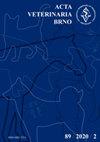Histopathological and immunohistochemical analysis of predictive and prognostic markers in spontaneous canine mammary cancer
IF 0.7
4区 农林科学
Q3 VETERINARY SCIENCES
引用次数: 0
Abstract
The study investigates the interspecies similarities between canine and human mammary cancer in the sense of innovative predictive and prognostic tumour markers. Surgical resection specimens with diagnosed spontaneous primary mammary cancer obtained from 100 female canine patients were included in this study. Expression of carbonic anhydrase IX (CAIX) enzyme and human epidermal growth factor receptor 2 (HER2) expression was evaluated immunohistochemically. The study was completed with investigation of Ki67 expression and proliferation with marker of myogenous differentiation. Histopathological grading was performed using the Nottingham/modified Bloom-Richardson system. As in humans, our analysis of canine mammary cancer has shown that CAIX positivity in tumour cells significantly correlates with higher levels of HER2 immunoreactivity (P = 0.001), and increased tumour grade (P < 0.001). The percentage of smooth muscle actin (SMA) positive cases was significantly higher (P = 0.002) in the group of mammary carcinomas with CAIX positivity compared to the tumours that were negative. Using antibody Ki67 proliferative activity was not significantly different between mammary tumours that were CAIX positive and CAIX negative. Canine mammary gland carcinomas may, therefore, represent valuable animal models for the study of hypoxic signaling pathways involved in mammary carcinogenesis in humans. Further research investigating this possibility is required.犬自发性乳腺癌的预测和预后标志物的组织病理学和免疫组织化学分析
该研究调查了犬和人类乳腺癌在创新预测和预后肿瘤标志物意义上的种间相似性。本研究纳入了100例确诊为自发性原发性乳腺癌的雌性犬患者的手术切除标本。免疫组织化学法检测碳酸酐酶IX (CAIX)酶和人表皮生长因子受体2 (HER2)的表达。以肌源性分化标志物Ki67的表达和增殖为研究终点。采用Nottingham/改良的Bloom-Richardson系统进行组织病理学分级。与人类一样,我们对犬乳腺癌的分析表明,肿瘤细胞中CAIX阳性与HER2免疫反应性水平升高(P = 0.001)和肿瘤分级升高(P < 0.001)显著相关。在CAIX阳性的乳腺癌组中,平滑肌肌动蛋白(SMA)阳性的比例明显高于阴性的肿瘤组(P = 0.002)。使用抗体Ki67的增殖活性在CAIX阳性和CAIX阴性的乳腺肿瘤之间无显著差异。因此,犬乳腺癌可能为研究人类乳腺癌发生过程中的缺氧信号通路提供了有价值的动物模型。需要进一步的研究来调查这种可能性。
本文章由计算机程序翻译,如有差异,请以英文原文为准。
求助全文
约1分钟内获得全文
求助全文
来源期刊

Acta Veterinaria Brno
农林科学-兽医学
CiteScore
1.00
自引率
33.30%
发文量
36
审稿时长
18-36 weeks
期刊介绍:
ACTA VETERINARIA BRNO is a scientific journal of the University of Veterinary and Pharmaceutical Sciences in Brno, Czech Republic.
The scientific journal Acta Veterinaria Brno is dedicated to the publication of original research findings and clinical observations in veterinary and biomedical sciences. Original scientific research articles reporting new and substantial contribution to veterinary science and original methods that have not been submitted for publication elsewhere are considered for publication. A written statement to this effect should accompany the manuscript, along with approval for publication by the author´s head of department. The authors bear full responsibility for the contents of their contribution. Book reviews are published, too.
 求助内容:
求助内容: 应助结果提醒方式:
应助结果提醒方式:


